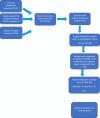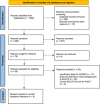Reflections on an Evidence Review Process to Inform the Co-Design of a Toolkit for Supporting End-of-Life Care Planning With People With Intellectual Disabilities
- PMID: 39403988
- PMCID: PMC11474664
- DOI: 10.1111/hex.70062
Reflections on an Evidence Review Process to Inform the Co-Design of a Toolkit for Supporting End-of-Life Care Planning With People With Intellectual Disabilities
Abstract
Introduction: There is growing recognition that healthcare inequalities faced by people with intellectual disabilities extend to their experiences at the end of life, resulting in calls for more inclusive research to help address these inequities. Our study aimed to address this through the co-design of a toolkit for supporting end-of-life care planning with people with intellectual disabilities. To inform the co-design process, we undertook an evidence review to identify existing tools, resources and approaches that were already being used in practice.
Methods: Our evidence review comprised three components: (i) a rapid scoping review of the academic literature, (ii) a desk-based search of the grey literature and (iii) an online survey to capture unpublished resources that were distributed to services, professionals, third-sector organisations and family members. A longlist of existing materials was appraised using an adapted version of the AGREE II instrument, resulting in a shortlist that was shared with the co-design team.
Results: The evidence review played a critical role in the co-design of a new toolkit of end-of-life care resources for people with intellectual disabilities. However, AGREE II proved to be limited for our purposes.
Conclusions: The survey was particularly useful in helping us identify resources, tools and approaches in current use. We identified evidence review processes that served to support co-design team activities and elements that were more problematic. We argue that evidence review practices might be enhanced to better aid co-design activities in health and care research, particularly for studies involving people with intellectual disabilities.
Patient or public contribution: This article reflects on an evidence review that was conducted as part of The Victoria and Stuart Project. People with intellectual disabilities were deeply involved at every stage of project design, delivery and dissemination. The project employed people with intellectual disabilities as members of the core research team. People with intellectual disabilities and family carers were members of the project co-design team and the project Advisory Group. The evidence review process itself was led by academic members of the research team with contributions from colleagues with intellectual disabilities via the Advisory Group and core research team. The findings from the evidence review were used by the co-design team to inform the development of an end-of-life care planning toolkit for people with intellectual disabilities.
Keywords: AGREE II; co‐design; evidence review; inclusive research; intellectual disabilities.
© 2024 The Author(s). Health Expectations published by John Wiley & Sons Ltd.
Conflict of interest statement
The authors declare no conflicts of interest.
Figures


Similar articles
-
Co-Designing a Toolkit of Approaches and Resources for End-of-Life Care Planning With People With Intellectual Disabilities Within Adult Social Care Settings: A Multi-Phase Study.J Appl Res Intellect Disabil. 2025 Jan;38(1):e70019. doi: 10.1111/jar.70019. J Appl Res Intellect Disabil. 2025. PMID: 39929779 Free PMC article.
-
The All Together Group: Co-Designing a Toolkit of Approaches and Resources for End-of-Life Care Planning With People With Intellectual Disabilities in Social Care Settings.Health Expect. 2024 Aug;27(4):e14174. doi: 10.1111/hex.14174. Health Expect. 2024. PMID: 39114930 Free PMC article.
-
Improving support and planning ahead for older people with learning disabilities and family carers: a mixed-methods study.Health Soc Care Deliv Res. 2024 Jun;12(16):1-161. doi: 10.3310/MTHW2644. Health Soc Care Deliv Res. 2024. PMID: 38940476
-
What are we planning, exactly? The perspectives of people with intellectual disabilities, their carers and professionals on end-of-life care planning: A focus group study.Palliat Med. 2024 Jun;38(6):669-678. doi: 10.1177/02692163241250218. Palliat Med. 2024. PMID: 38842172 Free PMC article.
-
Technology and the environment: supportive resource or barrier for people with developmental disabilities?Nurs Clin North Am. 2003 Jun;38(2):331-49. doi: 10.1016/s0029-6465(02)00053-1. Nurs Clin North Am. 2003. PMID: 12914311 Review.
Cited by
-
Co-Designing a Toolkit of Approaches and Resources for End-of-Life Care Planning With People With Intellectual Disabilities Within Adult Social Care Settings: A Multi-Phase Study.J Appl Res Intellect Disabil. 2025 Jan;38(1):e70019. doi: 10.1111/jar.70019. J Appl Res Intellect Disabil. 2025. PMID: 39929779 Free PMC article.
References
-
- “Briefing Notes for Researchers—Public Involvement in NHS, Health and Social Care Research: Ways That People Can Be Involved in the Different Stages of the Research Cycle,” National Institute for Health and Care Research, 2021, https://www.nihr.ac.uk/documents/briefing-notes-for-researchers-public-i....
Publication types
MeSH terms
Grants and funding
LinkOut - more resources
Full Text Sources

